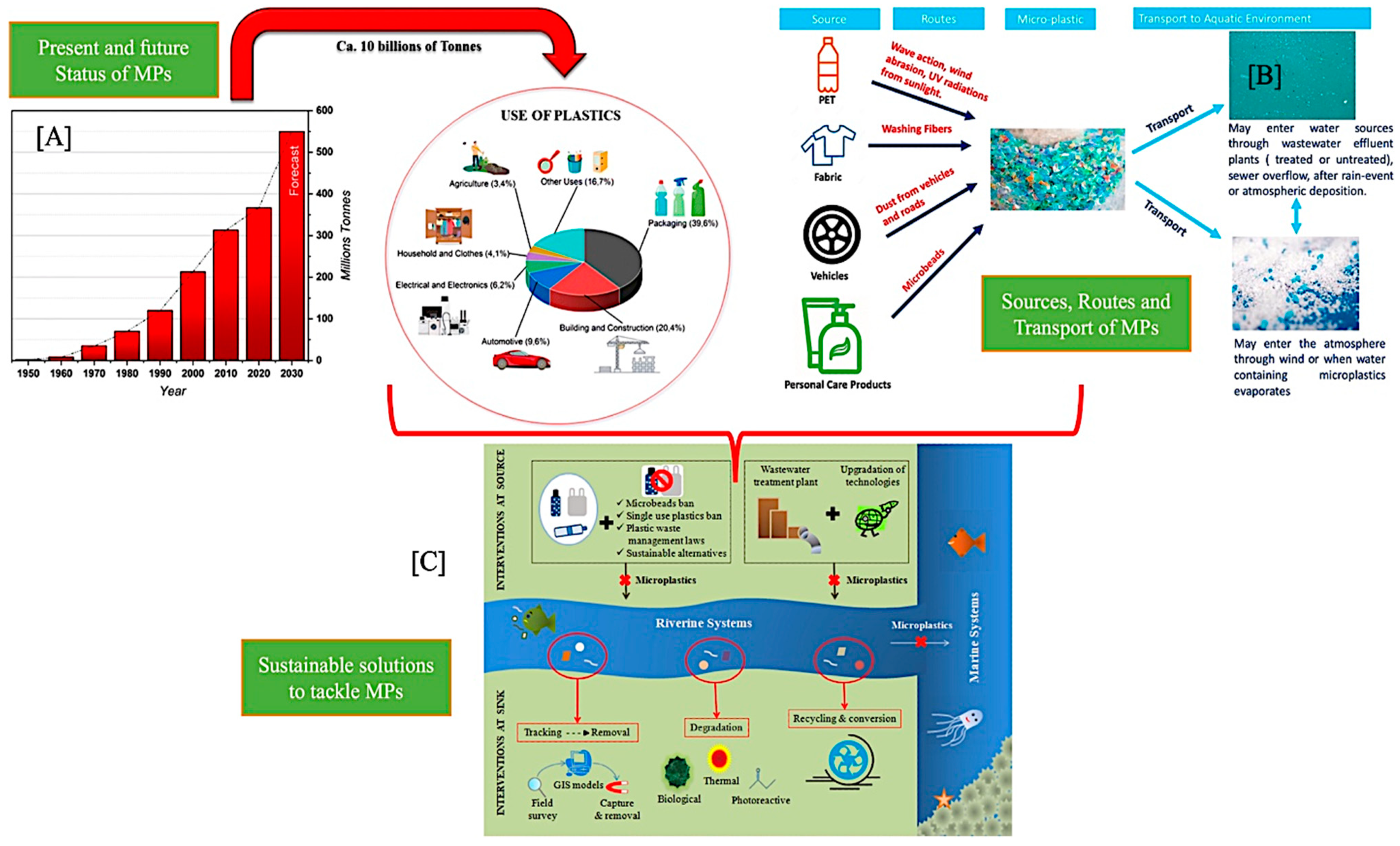Microplastic Pollutants in Aquatic Ecosystems: Present and Future Challenges
- An in-depth (surface to bottom) assessment of MP distribution in the water column and benthic sediment is required for a better understanding of how MPs interact with the system they inhabit;
- Intensification of source apportionment studies to better investigate the diffuse point sources necessitates the establishment of monitoring stations at hotspot locations;
- Discharge standards of MP pollutants should be uniform to minimize uncontrolled discharges;
- More R&D is needed to evaluate the behavioral alterations that MPs experience over the course of their lifetime;
- Research on the medium- to long-term effects of the trophic transmission of MPs in various food chains should be given top priority;
- For deeper insights into the variety of MP sources and/or sinks, advanced technologies and methodologies should be employed in conjunction with remote sensing (RS) and geographic information systems (GIS);
- Sustainable and cost-effective technologies should be explored for integration in current WWTPs to achieve a high rate of microplastic removal efficiencies;
- Revalidation of the circular flow model should be undertaken based on the working principle of the three Rs for sustainable management and mitigation of MP pollutants in the aquatic environment.
- How much MPs pollution is there currently in freshwater habitats, and how does it compare to the known levels of contamination in marine environments? Which polymers are the most prevalent and hazardous, and do these differ amongst aquatic environments, regions, and habitats?
- How much do the characteristics of various plastic materials and the environment impact the behavior and bioavailability of microplastics in freshwater and marine environments?
- Do negative consequences stem mainly from the particle’s physical impact, chemical toxicity, or combined effects, and how do they differ between species and polymers? Are there any similarities to what is understood about the mechanisms of action of some MPs?
- Under realistic exposure conditions (i.e., microplastics of the sort and amounts likely to be encountered by organisms), what are the potential ecological impacts of plastics?
Author Contributions
Acknowledgments
Conflicts of Interest
References
- Kumar, A.; Upadhyay, P.; Prajapati, S.K. Impact of Microplastics on riverine greenhouse gas emissions: A view point. Environ. Sci. Pollut. Res. 2022, 30, 107300–107303. [Google Scholar] [CrossRef] [PubMed]
- Paul, M.B.; Stock, V.; Cara-Carmona, J.; Lisicki, E.; Shopova, S.; Fessard, V.; Braeuning, A.; Sieg, H.; Böhmert, L. Micro- and nanoplastics—Current state of knowledge with the focus on oral uptake and toxicity. Nanoscale Adv. 2020, 2, 4350–4367. [Google Scholar] [CrossRef]
- Peng, X.; Chen, M.; Chen, S.; Dasgupta, S.; Xu, H.; Ta, K.; Du, M.; Li, J.; Guo, Z.; Bai, S. Microplastics contaminate the deepest part of the world’s ocean. Geochem. Perspect. Lett. 2018, 9, 1–5. [Google Scholar] [CrossRef]
- Horton, A.A.; Walton, A.; Spurgeon, D.J.; Lahive, E.; Svendsen, C. Microplastics in freshwater and terrestrial environments: Evaluating the current understanding to identify the knowledge gaps and future research priorities. Sci. Total Environ. 2017, 586, 127–141. [Google Scholar] [CrossRef] [PubMed]
- Ng, C.H.; Mistoh, M.A.; Teo, S.H.; Galassi, A.; Ibrahim, A.; Sipaut, C.S.; Foo, J.; Seay, J.; Taufiq-Yap, Y.H.; Janaun, J. Plastic waste and microplastic issues in Southeast Asia. Front. Environ. Sci. 2023, 11, 427. [Google Scholar] [CrossRef]
- Pandey, B.; Pathak, J.; Singh, P.; Kumar, R.; Kumar, A.; Kaushik, S.; Thakur, T.K. Microplastics in the Ecosystem: An Overview on Detection, Removal, Toxicity Assessment, and Control Release. Water 2023, 15, 51. [Google Scholar] [CrossRef]
- Duis, K.; Coors, A. Microplastics in the aquatic and terrestrial environment: Sources (with a specific focus on personal care products), fate and effects. Environ. Sci. Eur. 2016, 28, 2. [Google Scholar] [CrossRef] [PubMed]
- Geyer, R.; Jambeck, J.R.; Law, K.L. Production, use, and fate of all plastics ever made. Sci. Adv. 2017, 3, e1700782. [Google Scholar] [CrossRef] [PubMed]
- Shams, M.; Alam, I.; Mahbub, S. Plastic Pollution during COVID-19: Plastic Waste Directives and Its Long-Term Impact on the Environment. Environ. Adv. 2021, 5, 100119. [Google Scholar] [CrossRef] [PubMed]
- Huang, D.; Tao, J.; Cheng, M.; Deng, R.; Chen, S.; Yin, L.; Li, R. Microplastics and nanoplastics in the environment: Macroscopic transport and effects on creatures. J. Hazard. Mater. 2021, 407, 124399. [Google Scholar] [CrossRef]
- Afmataj, D.; Kordera, O.; Maragkaki, A.; Tzanakakis, V.A.; Pashalidis, I.; Kalderis, D.; Anastopoulos, I. Adsorption of Reactive Red 120 Dye by Polyamide Nylon 6 Microplastics: Isotherm, Kinetic, and Thermodynamic Analysis. Water 2023, 15, 1137. [Google Scholar] [CrossRef]
- Vivekanand, A.C.; Mohapatra, S.; Tyagi, V.K. Microplastics in aquatic environment: Challenges and perspectives. Chemosphere 2021, 282, 131151. [Google Scholar] [CrossRef] [PubMed]
- Vaid, M.; Sarma, K.; Gupta, A. Microplastic pollution in aquatic environments with special emphasis on riverine systems: Current understanding and way forward. J. Environ. Manag. 2021, 293, 112860. [Google Scholar] [CrossRef] [PubMed]
- Tran-Nguyen, Q.A.; Nguyen, T.Q.; Phan, T.L.T.; Van Vo, M.; Trinh-Dang, M. Abundance of Microplastics in Two Venus Clams (Meretrix lyrata and Paratapes undulatus) from Estuaries in Central Vietnam. Water 2023, 15, 1312. [Google Scholar] [CrossRef]
Disclaimer/Publisher’s Note: The statements, opinions and data contained in all publications are solely those of the individual author(s) and contributor(s) and not of MDPI and/or the editor(s). MDPI and/or the editor(s) disclaim responsibility for any injury to people or property resulting from any ideas, methods, instructions or products referred to in the content. |
© 2023 by the authors. Licensee MDPI, Basel, Switzerland. This article is an open access article distributed under the terms and conditions of the Creative Commons Attribution (CC BY) license (https://creativecommons.org/licenses/by/4.0/).
Share and Cite
Kumar, A.; Krishan, G. Microplastic Pollutants in Aquatic Ecosystems: Present and Future Challenges. Water 2024, 16, 102. https://doi.org/10.3390/w16010102
Kumar A, Krishan G. Microplastic Pollutants in Aquatic Ecosystems: Present and Future Challenges. Water. 2024; 16(1):102. https://doi.org/10.3390/w16010102
Chicago/Turabian StyleKumar, Amit, and Gopal Krishan. 2024. "Microplastic Pollutants in Aquatic Ecosystems: Present and Future Challenges" Water 16, no. 1: 102. https://doi.org/10.3390/w16010102
APA StyleKumar, A., & Krishan, G. (2024). Microplastic Pollutants in Aquatic Ecosystems: Present and Future Challenges. Water, 16(1), 102. https://doi.org/10.3390/w16010102






